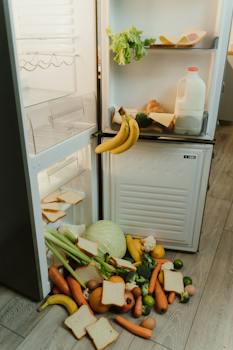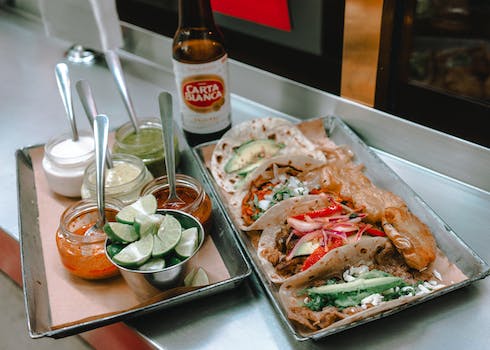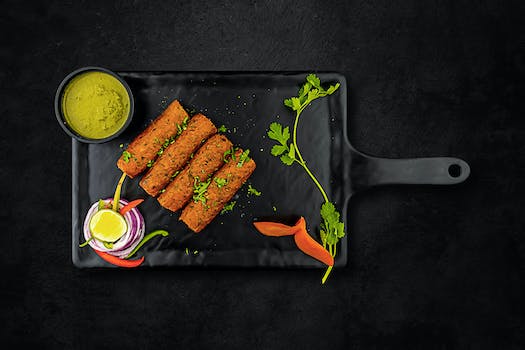

-
Table of Contents
"Smart strategies for a sustainable future: Minimize food waste, maximize impact."
Introduction
Introduction:
Strategies to minimize food waste are crucial in addressing the global issue of food loss and its associated environmental, economic, and social impacts. With approximately one-third of all food produced for human consumption going to waste, implementing effective strategies is essential for sustainable food systems. This introduction will explore various approaches and techniques that can be employed to minimize food waste, including improved storage and preservation methods, enhanced supply chain management, consumer education, and policy interventions. By adopting these strategies, we can work towards reducing food waste and creating a more sustainable and equitable food system for all.
Creative Meal Planning to Reduce Food Waste
Creative Meal Planning to Reduce Food Waste
Food waste is a significant problem that affects not only our wallets but also the environment. According to the Food and Agriculture Organization of the United Nations, approximately one-third of all food produced for human consumption is wasted globally. This wastage not only contributes to greenhouse gas emissions but also exacerbates food insecurity. To combat this issue, creative meal planning can be an effective strategy to minimize food waste.
One of the first steps in creative meal planning is taking stock of what you already have in your pantry, refrigerator, and freezer. By doing so, you can identify ingredients that are nearing their expiration dates or items that need to be used up. This inventory will serve as the foundation for your meal planning, allowing you to make the most of what you already have and avoid unnecessary purchases.
Once you have a clear understanding of your available ingredients, it's time to get creative with your meal ideas. Look for recipes that incorporate those ingredients, even if they are not traditionally used together. For example, if you have leftover vegetables and some pasta, you can whip up a delicious stir-fry pasta dish. By thinking outside the box, you can create unique and tasty meals while using up ingredients that might otherwise go to waste.
Another strategy to minimize food waste is to plan your meals around perishable items. Start by using ingredients that have a shorter shelf life, such as leafy greens or delicate fruits, at the beginning of the week. This way, you can ensure that these items are consumed before they spoil. As the week progresses, incorporate ingredients with longer shelf lives, such as root vegetables or canned goods. By strategically planning your meals, you can reduce the likelihood of food going bad before it can be consumed.
Leftovers often contribute to food waste, but they can also be a valuable resource in creative meal planning. Instead of letting leftovers sit in the refrigerator until they are no longer edible, incorporate them into new meals. For example, leftover roasted chicken can be transformed into a flavorful chicken salad or added to a stir-fry. By repurposing leftovers, you not only reduce waste but also save time and money by not having to cook an entirely new meal.
In addition to creative meal planning, proper storage techniques can also help minimize food waste. Invest in airtight containers or reusable wraps to keep fruits, vegetables, and leftovers fresh for longer periods. Labeling containers with the date they were prepared can also help you keep track of when they need to be consumed. By storing food properly, you can extend its shelf life and reduce the likelihood of it going to waste.
In conclusion, creative meal planning is a powerful strategy to minimize food waste. By taking stock of your ingredients, getting creative with your meal ideas, planning meals around perishable items, repurposing leftovers, and using proper storage techniques, you can significantly reduce the amount of food that goes to waste. Not only will this save you money, but it will also contribute to a more sustainable and environmentally friendly lifestyle. So, the next time you plan your meals, remember to think creatively and make the most of what you have.
Effective Storage and Preservation Techniques for Food

Effective Storage and Preservation Techniques for Food
Food waste is a significant global issue that not only impacts the environment but also contributes to hunger and poverty. According to the Food and Agriculture Organization (FAO), approximately one-third of all food produced for human consumption is wasted each year. This wastage occurs at various stages of the food supply chain, including production, processing, distribution, and consumption. To combat this problem, it is crucial to implement strategies that minimize food waste. One effective approach is to focus on proper storage and preservation techniques for food.
Proper storage is essential to maintain the quality and freshness of food, thereby reducing the likelihood of it going to waste. One of the most critical factors in food storage is temperature control. Different types of food require specific temperature ranges to stay fresh. For example, perishable items like meat, dairy products, and fresh produce should be stored in the refrigerator at temperatures below 40°F (4°C). On the other hand, dry goods such as grains, pasta, and canned foods can be stored at room temperature. By adhering to these temperature guidelines, we can extend the shelf life of our food and minimize waste.
Another crucial aspect of food storage is proper packaging. Packaging plays a vital role in protecting food from spoilage, contamination, and pests. It is essential to choose appropriate containers that are airtight and moisture-resistant. For example, storing leftovers in airtight containers or wrapping them tightly with plastic wrap can help prevent them from spoiling quickly. Similarly, using resealable bags for storing snacks or dry goods can help maintain their freshness for a more extended period. By investing in suitable packaging materials, we can significantly reduce food waste.
Preservation techniques are also valuable in minimizing food waste. One popular method is canning, which involves sealing food in airtight containers and heating them to destroy bacteria and other microorganisms. Canned foods have a long shelf life and can be stored for months or even years. Freezing is another effective preservation technique. By freezing food, we can extend its lifespan and preserve its nutritional value. However, it is crucial to package food correctly before freezing to prevent freezer burn and maintain quality.
Dehydration is another preservation method that involves removing moisture from food. This technique is commonly used for fruits, vegetables, and herbs. Dehydrated foods have a longer shelf life and can be rehydrated when needed. Additionally, pickling and fermenting are preservation techniques that have been used for centuries. These methods involve preserving food in a solution of salt, vinegar, or brine, which inhibits the growth of bacteria and extends the shelf life of the food.
In addition to storage and preservation techniques, proper inventory management is crucial in minimizing food waste. By keeping track of what we have and organizing our pantry and refrigerator, we can avoid buying unnecessary items and prevent food from expiring. First-in, first-out (FIFO) is a useful principle to follow when organizing food. It involves using older items before newer ones to ensure that nothing goes to waste. By implementing effective inventory management practices, we can reduce food waste and save money.
In conclusion, minimizing food waste is a global challenge that requires collective efforts. By focusing on effective storage and preservation techniques, we can significantly reduce the amount of food that goes to waste. Proper temperature control, suitable packaging, and preservation methods such as canning, freezing, dehydration, pickling, and fermenting are all valuable strategies. Additionally, practicing proper inventory management can help prevent food from expiring and going to waste. By implementing these strategies, we can contribute to a more sustainable and food-secure future.
Sustainable Shopping Habits to Minimize Food Waste
Sustainable Shopping Habits to Minimize Food Waste
In today's world, where food waste is a significant global issue, it is crucial for individuals to adopt sustainable shopping habits to minimize waste. By making conscious choices while shopping, we can reduce the amount of food that ends up in landfills and contribute to a more sustainable future.
One of the most effective strategies to minimize food waste is to plan meals and create a shopping list before heading to the grocery store. By knowing exactly what we need, we can avoid impulse purchases and only buy what will be consumed. This not only reduces waste but also saves money by preventing unnecessary purchases.
When creating a shopping list, it is essential to consider the shelf life of different products. Opting for fresh produce that has a longer shelf life, such as apples or carrots, can help prevent spoilage. Additionally, choosing products with a later expiration date can ensure that they are consumed before going bad.
Another sustainable shopping habit is to buy in bulk. Purchasing larger quantities of non-perishable items, such as rice or pasta, reduces packaging waste and can be more cost-effective in the long run. However, it is crucial to be mindful of the expiration dates and storage requirements of bulk items to avoid waste.
While shopping, it is important to pay attention to the quality and condition of the products we purchase. Inspecting fruits and vegetables for any signs of spoilage or damage can help ensure that we are buying fresh and healthy produce. Similarly, checking the packaging of other products for any leaks or damages can prevent us from buying items that may go bad quickly.
Choosing products with minimal packaging is another sustainable shopping habit that can significantly reduce waste. Opting for loose fruits and vegetables instead of pre-packaged ones not only reduces plastic waste but also allows us to buy only the amount we need. Similarly, selecting products with recyclable or biodegradable packaging can help minimize our environmental impact.
When shopping for perishable items, it is crucial to consider their storage requirements. Understanding how to properly store different products, such as keeping dairy products refrigerated or storing potatoes in a cool, dark place, can extend their shelf life and prevent unnecessary waste. Additionally, organizing the refrigerator and pantry to ensure that older items are used first can help avoid spoilage.
Lastly, being mindful of portion sizes can significantly reduce food waste. By accurately estimating the amount of food needed for meals, we can avoid cooking or serving excessive portions that may go uneaten. Leftovers can also be repurposed into new meals or frozen for later use, preventing them from being wasted.
In conclusion, adopting sustainable shopping habits is essential to minimize food waste. By planning meals, creating shopping lists, buying in bulk, choosing quality products, opting for minimal packaging, understanding storage requirements, and being mindful of portion sizes, we can make a significant impact in reducing food waste. It is our responsibility as consumers to make conscious choices while shopping and contribute to a more sustainable future.
Q&A
1. What are some strategies to minimize food waste?
- Plan meals and create a shopping list to avoid buying excess food.
- Store food properly to maintain freshness and prevent spoilage.
- Use leftovers creatively by incorporating them into new dishes.
- Donate excess food to local food banks or shelters.
- Compost food scraps to reduce waste and create nutrient-rich soil.
2. How can meal planning help minimize food waste?
- Meal planning allows you to buy only the necessary ingredients, reducing the chances of food going unused.
- It helps you utilize leftovers effectively by incorporating them into future meals.
- By planning meals in advance, you can ensure that perishable items are used before they spoil.
3. Why is proper food storage important in minimizing food waste?
- Proper food storage helps maintain freshness and quality, extending the shelf life of food.
- It prevents food from spoiling prematurely, reducing the likelihood of waste.
- Storing food correctly also helps prevent cross-contamination and foodborne illnesses.
Conclusion
In conclusion, implementing strategies to minimize food waste is crucial in addressing the global issue of food waste. By raising awareness, improving storage and transportation systems, promoting responsible consumer behavior, and encouraging collaboration among stakeholders, significant progress can be made in reducing food waste and its associated environmental, social, and economic impacts. It is essential for individuals, businesses, and governments to work together to implement these strategies and create a more sustainable and efficient food system.












